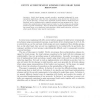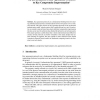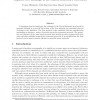SCN
2010
Springer
14 years 1 months ago
2010
Springer
The Canetti–Krawczyk (CK) and extended Canetti–Krawczyk (eCK) security models, are widely used to provide security arguments for key agreement protocols. We discuss security s...
JUCS
2008
14 years 2 months ago
2008
Unknown Key-Share (UKS) resilience is a basic security attribute in authenticated key agreement protocols, whereby two entities A and B should not be able to be coerced into shari...
JCP
2006
14 years 2 months ago
2006
Abstract-- This paper is concerned with passwordauthenticated key agreement protocols. Designing such protocols represents an interesting challenge since there is no standard way o...
IJNSEC
2008
14 years 2 months ago
2008
Despite the importance of proofs in assuring protocol implementers about the security properties of key establishment protocols, many protocol designers fail to provide any proof ...
DAM
2006
14 years 2 months ago
2006
Abstract. Artin's braid groups currently provide a promising background for cryptographical applications, since the first cryptosystems using braids were introduced in [2, 3, ...
CCS
2008
ACM
14 years 4 months ago
2008
ACM
The Unified Model (UM) key agreement protocol is an efficient Diffie-Hellman scheme that has been included in many cryptographic standards, most recently in the NIST SP 80056A sta...
ASIACRYPT
2000
Springer
14 years 6 months ago
2000
Springer
A conference key protocol allows a group of participants to establish a secret communication (conference) key so that all their communications thereafter are protected by the key. ...
EUROPKI
2006
Springer
14 years 6 months ago
2006
Springer
Abstract. Key agreement protocols are a fundamental building block for ensuring authenticated and private communications between two parties over an insecure network. This paper fo...
ICDCS
2002
IEEE
14 years 7 months ago
2002
IEEE
Group key agreement is a fundamental building block for secure peer group communication systems. Several group key agreement protocols were proposed in the last decade, all of the...
INDOCRYPT
2004
Springer
14 years 8 months ago
2004
Springer
A definition of secure multi-party key exchange in the Canetti-Krawczyk proof model is proposed, followed by a proof of the security of the Joux tripartite key agreement protocol...



